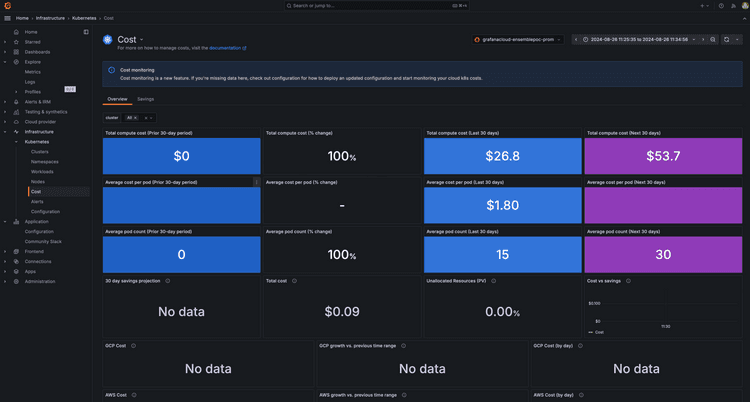
Maximizing ROI in Observability: A Guide to Managing Costs Without Compromising Visibility
Learn how to optimize observability costs without sacrificing visibility. Discover strategies for managing data ingestion, retention, and alerting, and explore cost-saving features like event sampling and adaptive filtering. See how automation and streamlined workflows can enhance ROI and improve system reliability.
Maximizing ROI in Observability: A Guide to Managing Costs Without Compromising Visibility
Striking the Balance Between Cost and Value
Struggling to control the rising costs of your observability tools? You’re not alone. Many organizations face the challenge of balancing comprehensive monitoring with budget constraints. Observability is critical for ensuring system reliability and performance, but unchecked costs can quickly erode its value.
In this guide, we’ll explore practical, data-driven strategies to optimize your observability costs without sacrificing visibility. By understanding the key cost drivers and implementing smarter workflows, you can maximize the return on your investment (ROI) in observability tools like New Relic.
Understanding the Cost Drivers in Observability
To manage costs effectively, it’s essential to know what’s driving them. Key factors include:
1. Data Ingestion and Retention
Observability platforms charge based on the volume of logs, metrics, and events ingested. Longer retention periods amplify these costs.
2. Over-Provisioned Dashboards and Alerts
Monitoring non-critical metrics or setting overly sensitive alerts creates noise and increases resource usage.
3. Inefficient Use of Platform Features
Many teams fail to take full advantage of cost-saving tools like event sampling, filtering, and storage extensions.
Example: In our guide on Extending Browser Event Storage, we demonstrated how New Relic users can reduce costs by customizing storage settings to retain only the most valuable data.
Quick Tips for Managing Observability Costs
If you’re short on time, here are the top strategies at a glance:
• Focus on critical metrics and transactions.
• Optimize data retention policies.
• Use sampling and filtering to reduce ingestion volumes.
• Streamline alerts to avoid unnecessary noise.
• Regularly audit tool usage and licensing agreements.
Let’s dive deeper into these strategies.
Strategies for Observability Cost Management
1. Prioritize Critical Metrics and Events
Not all data has equal value. Identify the metrics and transactions that directly impact your business outcomes. For example:
• Monitor customer-facing features (e.g., payment flows).
• Focus on distributed tracing for high-priority applications.
2. Optimize Data Retention Policies
Customize retention periods based on data importance:
• Retain critical logs for longer periods.
• Use shorter retention for high-frequency, low-value logs.
3. Leverage Cost-Saving Features
Observability tools like New Relic offer built-in features to reduce costs:
• Event Sampling: Reduce ingestion by capturing only a representative subset of events.
• Adaptive Filtering: Filter out less valuable logs at the source.
• Custom Storage Extensions: Extend storage selectively for high-value data.
4. Streamline Alerting Mechanisms
Tie your alerts to Service Level Objectives (SLOs) or error budgets. This ensures your team focuses on resolving the most critical issues and avoids unnecessary notifications. Our guide on Missing Transactions offers more insights on improving alert accuracy.
5. Audit Tool Usage and Licensing
Regularly review your observability stack. Are you paying for features you don’t use? Align your licensing with your actual needs to uncover hidden savings.
The Role of Automation in Cost Savings
Automation is a game-changer for cost management in observability. By automating key workflows, you can reduce operational overhead and ensure consistent monitoring. Key areas for automation include:
• Log analysis and anomaly detection.
• Alert resolution workflows.
• Scaling monitoring infrastructure based on demand.
Case Study: Observability Cost Optimization in Action
A SaaS company approached us with concerns about rising observability costs. They were struggling with excessive data ingestion and ineffective alerting. Here’s how we helped:
1. Challenges:
• High data ingestion volumes from non-critical logs.
• Noise from overly sensitive alerts.
• Rising storage costs for retained browser events.
2. Solutions:
• Implemented event sampling to reduce ingestion by 98.9%.
• Adjusted retention policies for low-priority logs.
• Optimized browser event storage using New Relic’s custom extensions.
3. Results:
• 53% reduction in observability costs.
• 465,000 to 5,000 reduction in daily data points stored.
• Enhanced visibility into critical systems without overspending.
This approach saved the company thousands of dollars annually while improving their observability ROI.
Let’s Optimize Your Observability Costs
Observability is a crucial investment, but it doesn’t have to break the bank. At O11y, we specialize in helping organizations streamline their observability strategies, eliminate waste, and achieve better results.
Ready to take control of your observability costs? Let’s talk. Schedule a consultation today to start optimizing your setup and saving money.